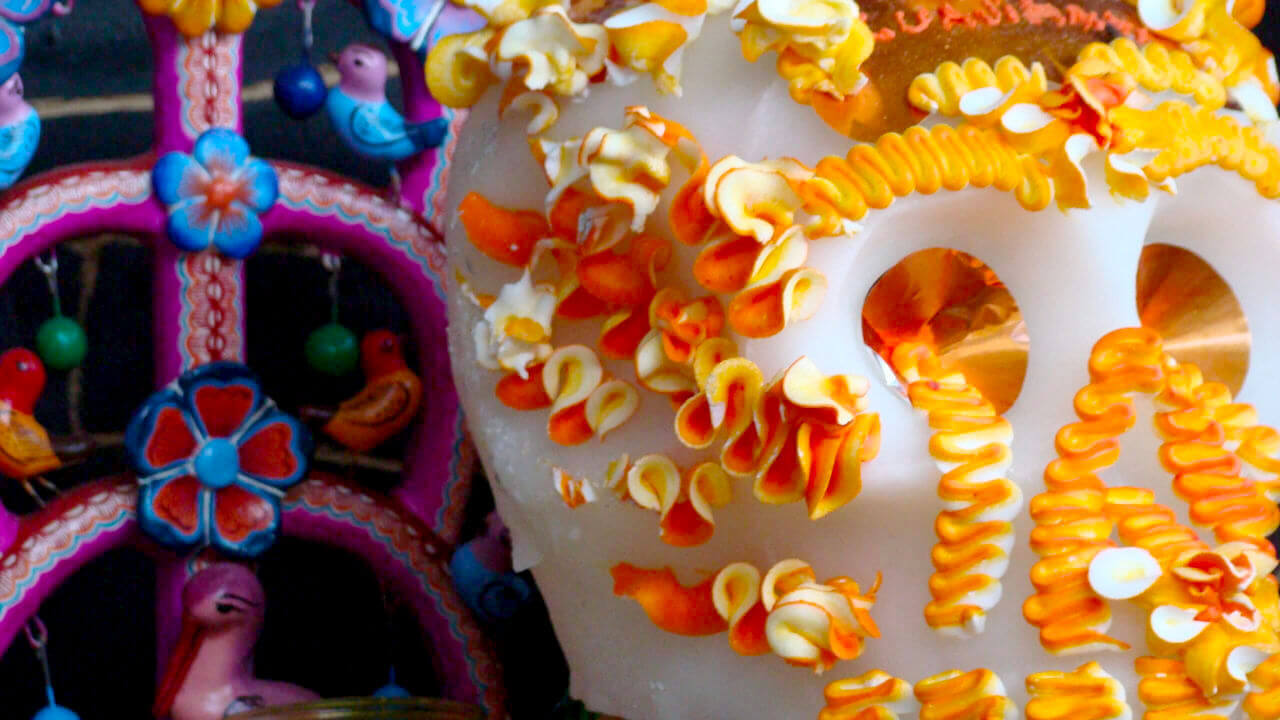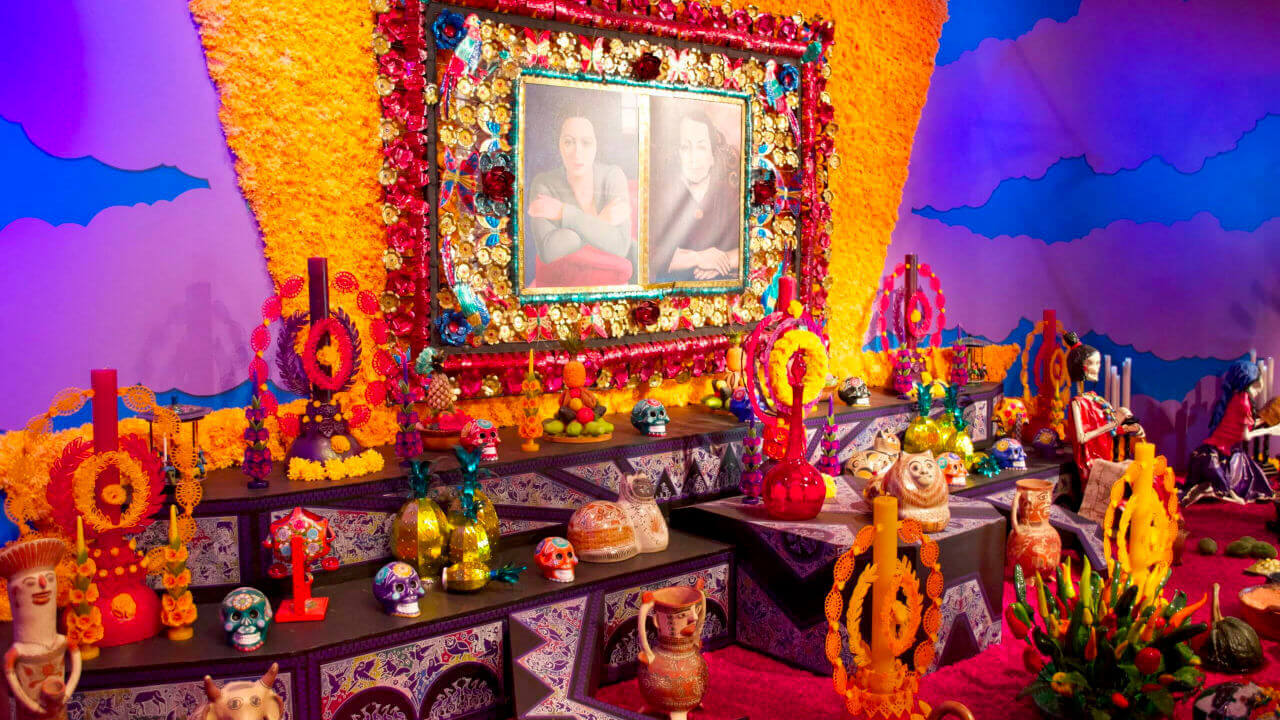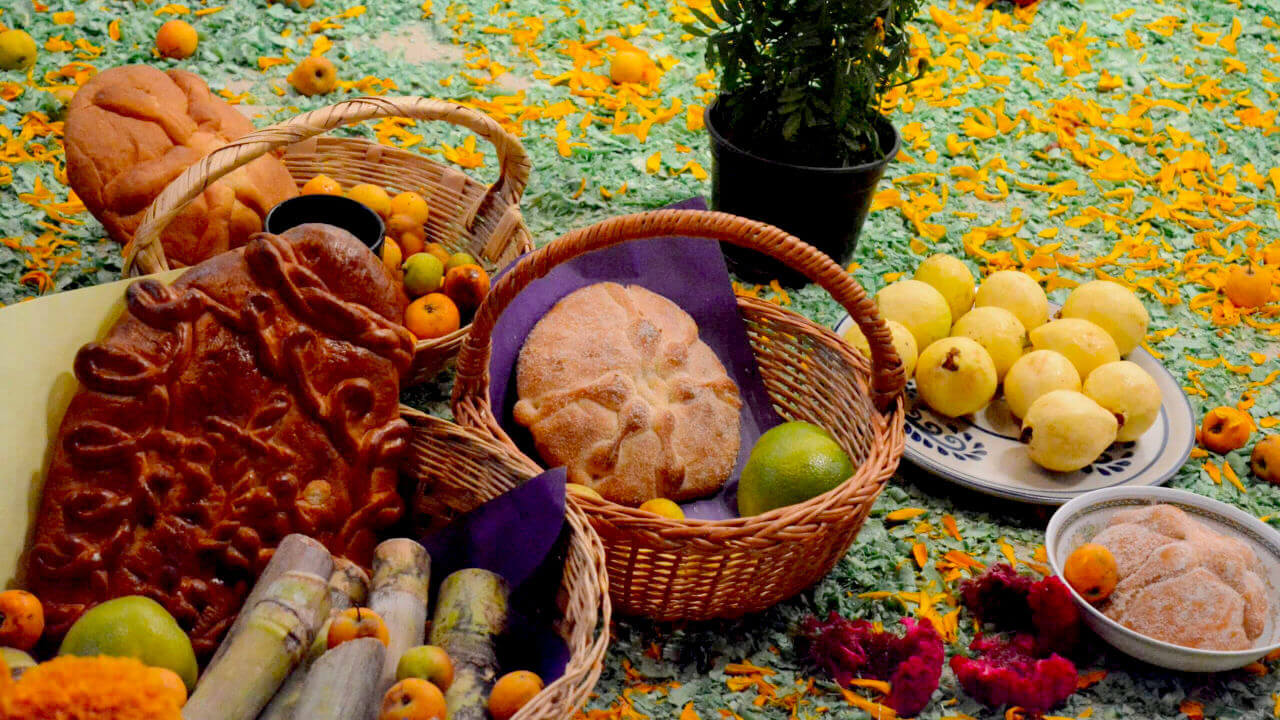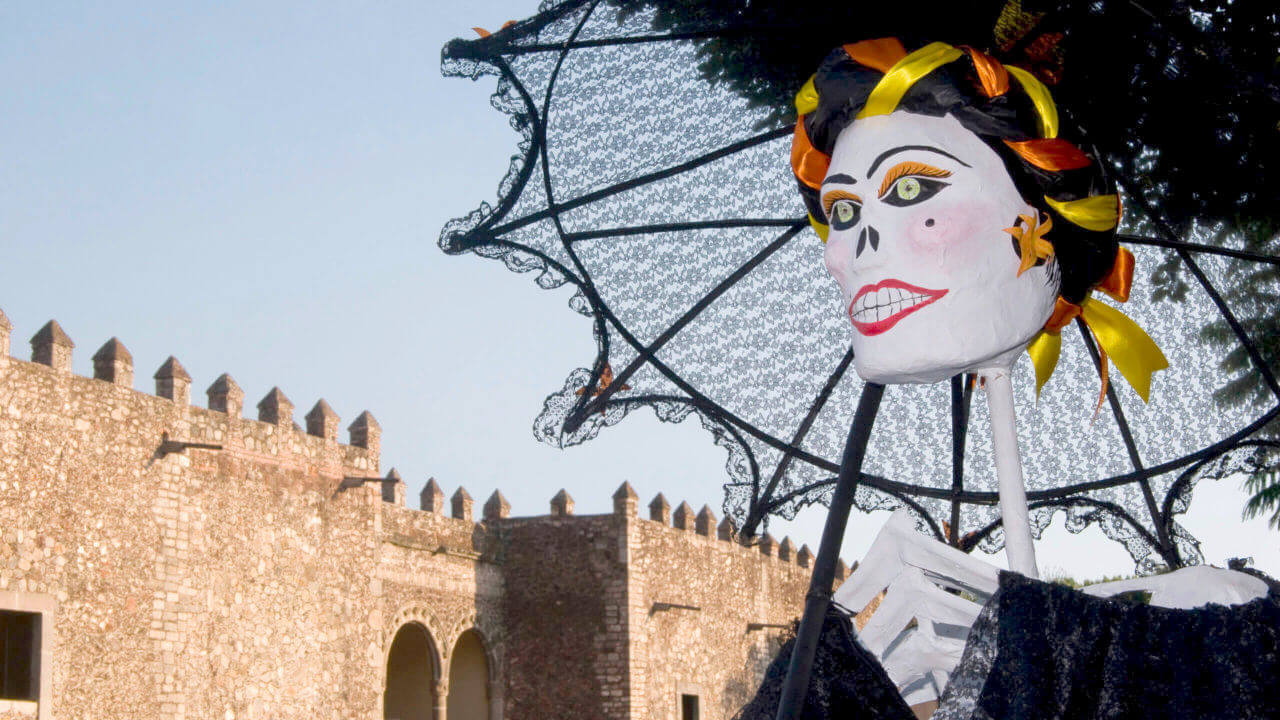
The Mexican Day of the Dead known also as Día de Muertos or Día de los Muertos is perhaps one of the most famous death rituals around the globe. From classic imagery of people in candle-lit graveyards to inspiring Pixar movies (for example Coco, 2017), this is an iconic celebration of the Dead.
It also undoubtedly offers a much more positive approach towards grieving and how death is perceived!
The Day of the Dead is very similar to the Catholic All’s Souls Day and takes place the first two days of November. Specifically, the first of November focuses on the spirits of children and the second on adults. However, in practice most Mexicans celebrate their dead jointly.
By mid-18th century this death celebration had already taken its current name: The Day of the Dead. Similar celebrations exist in many Latin American countries, certain parts the USA and Spain.

Historians and anthropologists still debate about the exact origin of the Mexican Day of the Dead. A popular view is that the Día de Muertos dates back to the American indigenous populations and their customs.
For instance, the Aztecs had the notion of traversing through the hardships of Mictlan, the underworld. Moreover, they believed that the dead needed to embark on a four year journey in order to travel through the Mictlan. Therefore, death was, not seen as the end, but the beginning of a long journey.
This notion of a journey after death is present also in modern Mexican views of death and the afterlife. Indeed, these very ideas also lie in the heart of the custom of the Day of the Dead. Mexicans believe that the dead visit the Land of the Living once per year in order to reunite with their loved ones.
During the period of Hispanic colonization, many indigenous traditions changed or combined with Christian customs. The Spanish used this approach to promote the assimilation of the local populations. As a result, the Day of the Dead ends up borrowing both indigenous Native American as well as Christian Hispanic elements.
Some researchers have supported that this emphasis on the indigenous origins of the Día de Muertos was a politically move. Specifically, they suggest that the first independent Mexican governments advocated this notion in order to shake away Hispanic heritage. Since there were traditions originating from the Catholic Church and the All Saints’ Day, Mexican governments need a new approach. Therefore, they started using the term All Souls’ Day in order to take distance with Spanish colonial customs and terms.

Regardless of its origin, the Day of the Dead is the most famous Mexican death tradition. Next, we are exploring how a traditional Day of the Dead altar looks like focusing on the iconic Ofrendas, the Altars of the Dead. For this endeavor we are assisted by Aura Méndez Lecomte, one of our own Myend employees who originally comes from Xalapa, Veracruz. An average Ofrenda, contains usually most of the following elements:
Mexican place skulls made of sugar (‘calaveras de azúcar’) on the altar. Each skull has a name of a departed relative on its forehead and is important for summoning the souls. Moreover, these calaveras often have drawings in vibrant colors.
Special flowers such as Mexican marigolds, cempasúchi in Spanish, and red cockscombs are common decorations for the altar. In addition to these, Mexican use palm tree leaves in order to create an arch that works as a gateway for the dead. Mexicans also use the petals of cempasúchil to make a path in front of the altar to guide the dead around so they do not get lost. Sometimes this path of flowers even reaches the front door of the house.

Mexican lay perforated paper, or Papel picado, on or around the table of the altar. It has holes and a variety of depictions of skeletons. This paper is always in a bright color and people make intense colorful combinations. It is also quite fragile, which according to some represents the fragility of life itself. Papel picado is often also hanging from the ceiling of restaurants or forms arches above streets.
According to some traditions, people also add salt on the table of the altar, often in the shape of a cross in order to purify the souls of the dead. Moreover, they burn copal, a specific kind of resin. This incense’s goal is to ward off any bad spirits that would cross over during the Day of the Dead.

But that is not all! There are many edible offerings presented at each ofrenda. Usually that includes meals and drinks that the dead used to enjoy while they were alive. Specifically, Mexicans often place food by an altar as an offering to the dead. Ethnographic studies indicate that the dead consume the flavor and the aroma of the food. Moreover, some support that they also ‘eat’ the nutritional value of the food, while the the physical food itself is for the living. Therefore, the dead consume the essence of the of food. Here are some more foods and drinks that Mexican prepare for the Day of the Dead.
It is common for people to use Mezcal or pulque for home altars but not so much for altars prepared for cemetery. Moreover, a glass of water is often on altars. The reason for this is that the dead are very thirsty upon their arrival to the Land of the Living.

The bread of the dead, Pan de Muerto in Spanish, is one of the most characteristic foods for this occasion. It is sweet bread with sugar on top that Mexicans consume already for weeks before the actual Day of the Dead. Also, it has many regional variations!
Pan de Muerto is usually decorated with shapes of bones and skulls and people have it often with a cup of delicious hot chocolate. It is common to see Mexicans having that even at school or their workplace. Additionally, families meet up weeks before the Day of the Dead to bake and eat these bread together. In this respect the Día de Muertos is almost like a family reunion both with the dead and the living!
Finally, tamales is a savory traditional meal for the Day of the Dead. We could approximately describe it as corn dough with chicken or pork mixed with herbs and packed usually in a banana leaf. After all the ingredients are in leaf, Mexican steam them so all flavors mix together.
Ofrendas? Check! Food? Check! The final crucial component for the Day of the Dead is is of course music and other forms of art!
There are certain folk songs that Mexicans play at cemeteries next to the gravesides of their relatives. The customs support that these songs can summon the spirits of the dead in melodious chanting. An example of such a song would be the following:
A translation of the lyrics would be:
Come out, come out, come out.
Sorrowing spirits.
May the Holy Rosary.
Break your chains
We have already mentioned that Mexicans use sugary Calaveras. In addition to that, fake skulls and skeletons often play an important role during the Day of the Dead. Skulls have vibrant colors, flowery patterns and decorations, providing a more humorous and light approach to death and the dead. There are also certain figurines of fleshless skeletons that can be seen dressed in clothes.
An iconic presence during the Day of the Dead is La Calavera Catrina, the skeleton lady Catrina who to an extent has become the face of the Day of the Dead. Her current form is mostly a result of the work of José Guadalupe Posada and Diego Rivera. Young girls and older women alike are getting dressed up as her during the Day of the Dead, while men may get dressed up as a male skeleton version of her. Historically, there are also elements of political satire embedded to La Calavera Catrina. Figurines and effigies of La Catrina can also be seen everywhere around.

In a way it is death itself that is mocked during this celebration of life, and none of these traditions are seen disrespectful towards the dead. Although the loss of a loved one is a serious and painful affair, Mexicans allow space for a more celebratory and humorous approach of death and the Día de los Muertos is the perfect manifestation of that.
We hope you learned something new regarding this country’s death practices!
If you want read more on other celebrations of the dead, how about having a look at our article on Madagascar‘s Famadihana. On that note, you can also read about the Toraja people who exhumate and spend time with their dead. Finally, for more on other lighter approaches to death, we recommend our article about the Merry Cemetery in Romania.
The average mixed death rate in Mexico is 6,01 per 1.000 people (2018). After reaching an all-time low in 2002 (4,689 per 1.000), it has been steadily on the rise.
The burial has to take place within 12 to 48 hours after death, unless the authorities have said otherwise.
Mexico is largely a Christian country with Catholicism reaching over 82% of the population! There is also a Protestant minority of about 6%.
According to the Mexican National Transplantation Center (Centro National de Trasplantes), there 551 utilized donated organs in 2019. That corresponds to a rate of utilized organs of 4,35 per million population.